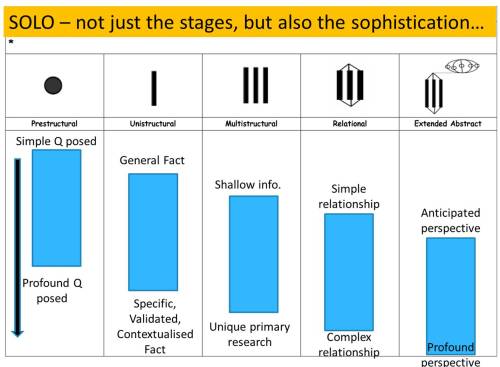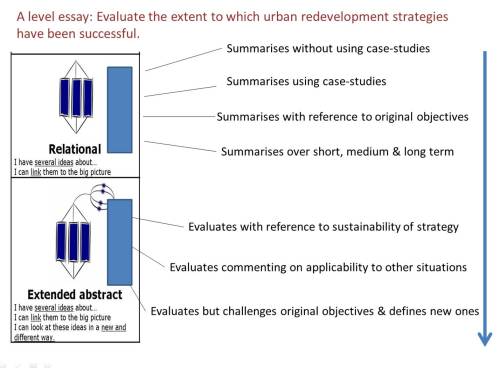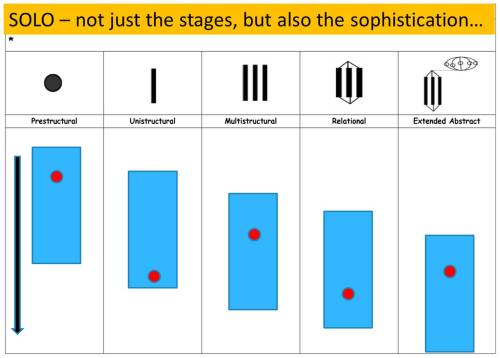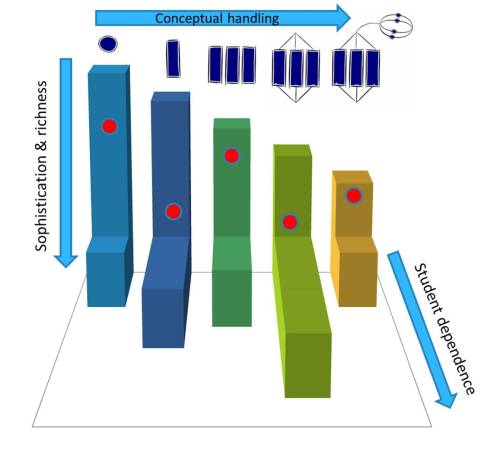Ok, so now I’ve inducted all my groups, from Y8 to Y13 into SOLO’s language, concepts and progression. It wasn’t what I intended back in November when I tentatively focused on Y8 to explore its potential; it just became increasingly elemental to all that I was doing with the other classes. We don’t mention it every lesson, but it lies there in my thinking ready to surface and puncture into the classroom when its appropriateness asserts itself.
There is a ‘however’, though. Frequently students are so keen to slide through SOLO’s conceptual stages to jump into the Relational or Extended Abstract that their dalliance with Uni-and Multi-structural is superficial and not of the depth or quality that I think they should be aiming for. This has been increasingly an issue with Y11 at times over the year; offering factually correct statements but which lack the specific, the precision or the sophistication that I know they are capable of. Sometimes it is just that they skip onto the ‘obvious’ stepping stones across the stream that everyone else traipses instead of wading deeper and forcing their own individual route through that would give their answers originality. If I read of any more Problems of Tourism stating ‘litter’ as a key issue – I’m likely to tip the bin onto someone’s desk. It’s too glib, too obvious, too far from a priority problem – and too many average candidates will write it. I want my students to think the answer less often thought and impress themselves, me and the examiner with subtlety, with depth of thinking and maturity of precision.
So we are engaging in 2D SOLO. We are digging wells. We’re boring down and going deeper. The model we are using looks like a series of vertical columns with the Y axis representing greater sophistication as well as moving from the ‘usual’ to the ‘less frequently identified’ points. We have spent whole lessons exploring rich Uni-structural, then Multi-structural information, and constrained ourselves from consideration of any further stages until we’ve mined deeply within them. Presented with a photo of a Majorcan beach resort we have sidelined the ‘obvious’ Physical Attractions of ‘sunny weather’ for ‘high probability of sunshine in the main tourism months of July and August’; ditched ‘warm sea’ for ‘calm, clear tideless Mediterranean’; deposed ‘trees on hills’ for ‘shaded coniferous pine-forest from where attractive views of the bay can be seen’.
The concepts are the same but the information is more deliberate, exact and embracing richer geography. We’ve developed this search for more illustrious descriptors using challenges such as an inverted form of ‘Pointless’ – where groups share the key ideas they’ve come up with – only getting one point if 3 or more other groups also have it, 3 points if only one other group have it, and 6 points if they have a ‘unique’ point. (There is also a bonus of 8 if they come up with a valid point that hadn’t occurred to me). It is generating a richer range of specific information that provides the material for moving on to the Relational phase seeking the connections, classifications and relationships within the accumulated information. What has become clear is that this is an exploration of not just deeper geography, but literacy too. Seeking the precise descriptive term requires an examination of language and selection of appropriate phrasing. It is a habit that needs working, practising, repeated flexing but is beginning to gain traction.
Similarly with Relational thinking it’s not difficult to identify ’cause’ and ‘effect’ in many geographical issues. Rivers flood. This is caused by…..heavy rain. It leads to….lost crops…shortages of food….rising prices…. These are links my Y8 came up with last week. What do I want my Y11s to be able to state that is commensurate with their greater sophistication to the same question? Both year groups are working on this topic at a Relational level, but I expect more of those 3 years older. I expect it based upon an exemplar; a named river that flooded at a precise time with the preceding weather conditions contributing to a saturated surface such that additional rain contributed to surface flow….. We’re still doing ‘Relational’ but with greater precision and complexity.
Y13 have planned conclusions to their most recent essay working on deeper level ‘extended abstract’ levels. It’s an exercise in reflection for them to consider just what it is that makes for progress in the subject – particularly at the higher grades. What does a really high quality evaluative conclusion look like compared to merely a ‘good’ one? What distinguishes the A* from the A? I’m finding 2D SOLO is a helpful vehicle to explore these two dimensions of the subject with my students.
What it also accommodates is the possibility of a deep, rich, Unistructural piece of information demonstrating greater ‘depth’ than two or three facts at a superficial Multistructural level. We have set up time-trials during information research activities whereby one group aims to come up with one very rich piece of information in the specified time, to compete with another group that is charged with coming up with the largest range of facts – by necessity pretty generalised. A third group then decides which is the most useful research outcome to the question under investigation – the single piece of sophisticated information or the wider variety of more general information. This potential for variation in the 2D performance at different SOLO Levels by the same student lends itself to profiling individual student attainments.
A recent assessment essay by a Year 9 produced the following profile : occasional very detailed researched information (deep Unistructural), but other paragraphs subsisting with generalised points that could have been exemplified with data more effectively (shallower Multistructural). The connectives were particularly well developed and the student had some impressive ’cause and effect’ chains of links further classified into ‘local’ effects and ‘international’ effects (deep Relational), but a disappointingly bland conclusion that didn’t really make as much of the material as it could have (fairly shallow Extended Abstract). From this performance profile it became clear what to suggest to the student to focus on in order to demonstrate further progress in future assignments. The language of ‘what went well’ and ‘what is needed for future progress’ leaps out from the 2D SOLO profile.
But I think there is a third dimension too. We have become adept at creating the conditions for our students to perform the best they can. We prime, pre-load, scaffold and structure as a matter of course. I wonder how much those National Curriculum Levels mean when we’ve drafted on planning grids, word-frames and essay-hot maps compared with the student who produces the same assignment with much less assistance. There has to be a value ascribed to independence in researching information, extracting meaning, structuring discourse and self-motivating towards a long-term objective. If we are trying to help students ‘achieve’ and demonstrate ‘progress’- then this is in conceptual skills (SOLO levels), information precision (2D) and the ability to set their own learning course, becoming less dependent on the teacher. And this is the 3D dimension – the encouraging of students to become less reliant on seeking reassurance at every step (or having to be led by the nose), to be confident that they can engineer their learning course themselves. Isn’t it what PhD students do – set their own questions, follow a route to abstract conclusions, forecasts and hypotheses and generate unique research only occasionally touching base with a tutor? This is what we deem the highest level of academic performance. How that independence is achieved with a mixed-ability group of 14 year olds I am still working on. But this is the next challenge – to develop the resilience to be self-motivated, the confidence to know that guidance will ultimately be provided but maybe not at the first asking, and the tenacity to keep the end-objective in mind.
That same Y9 student showed real progress in Relational connections. But it was with considerable assistance and prompting from me. The profile indicates that the areas where he relied on his own self-direction – the Multistructural phase and the Extended Abstract conclusion – he didn’t achieve quite the sophistication as when he was assisted. That shows me that next time, his progress in these areas needs to be guided a little more closely to achieve the deeper levels, but then I need to withdraw and encourage his replication of the same depth of performance, but with more independence and self-sufficiency.
Tom Sherrington @headguruteacher in this post ponders whether there are more appropriate measures of student progress than the artificial NC sub-levels. As we contemplate the demise of NC levels under DfE proposals we will require something to replace them as a measure of progress. I’m becoming more convinced that there is potential here. Yes – it won’t provide neat categorical numbers or letters with which to fill spreadsheets and determine ‘3 levels of progress’. But 3D SOLO-based student profiling could offer a more analytical and rounded impression of progress needs than many of the procedures we use at the moment that seem designed to generalise and compromise. I think there is virtue in a formative assessment system that can advise a student how to advance along conceptual stages, probe depths of sophistication and develop self-reliance in their learning. That would be a journey of multiple dimensions worth exploring.





I am planning on using SOLO for the first time ever this week with a year 8 class. You have helped me clarify my thinking about the boundary between multi structural and relational and helped me to raise my expectation of pupils even at the planning stages by making me think about the depth of thinking required at unistructural and multistructional level. Thanks.
That feedback is really appreciated. So glad it’s been useful. Hope you have an enlightening lesson with your Y8s – the first of many using SOLO.
Pingback: Planning for a SOLO performance in the Exam Hall | meridianvale
Pingback: How NC Levels became the Emperor’s New Clothes | meridianvale
Pingback: 2D & 3D SOLO: exploring new dimensions | te...
Pingback: Notes on a coup: TLT13, Teaching and Learning Takeover | Improving Teaching